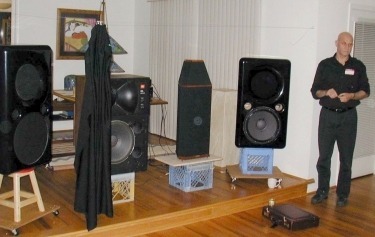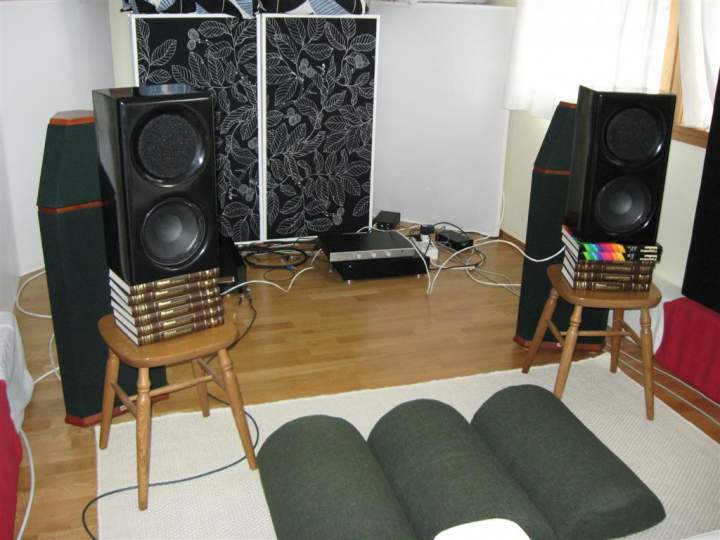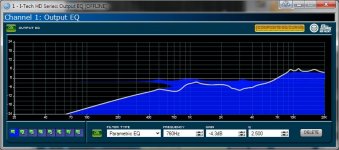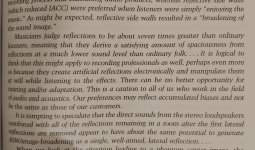If memory serves me:
1) Earl Geddes was using JBL speakers for a while
2) He designed the Summas to address deficiencies in the JBLs
3) I bought a set (I'm certain of that part lol)
4) During an ABX comparison between the JBLs, the Summas, and a set of Gradient Revolutions, the JBLs came in last, the Summas second, and the Gradients were first.
I can't find the original article. Here's a pic of the comparison, the Gradients are the small black speakers:


Are these the same Gradients? Not sure.
Earl discusses directivity index, and further improvements to the Summa:
YouTube
I'm a bit late to the party; just stumbled across this thread.
I provided the Gradient Revolution used in the test shown in the first photo. I also shuffled speakers under Earl's direction behind the curtain during the test.
My recollection is that the Gradients and B&C-equipped Summas were tied for first. The TAD-equipped Summas were third, and the JBL 4430's were fourth.
I don't know anything about the second photo showing Gradients. As far as I know, those smaller GedLee speakers did not exist yet when we did the Summa test.
It's from a previous setup I had. The smaller GedLee speakers in the picture are Abbey.I don't know anything about the second photo showing Gradients. As far as I know, those smaller GedLee speakers did not exist yet when we did the Summa test.
I had a setup with three Abbeys and two Harpers in a home theater for a while.
It's from a previous setup I had. The smaller GedLee speakers in the picture are Abbey.
I had a setup with three Abbeys and two Harpers in a home theater for a while.
Ah, thanks for letting me know.
On another note, more directly related to the opening post, I can't help but wonder whether the M2's off-axis response is as good as the published curves imply. Let me explain:
If you look into the throat of the M2's horn, you'll see "knuckles" at north, south, east and west. These knuckles are presumably diffractive devices which spread the high frequency energy far wider than it would otherwise spread, at least in a fairly narrow north-south wedge and another fairly narrow east-west wedge. At other angles - those which don't illuminate the "knuckles" - there is little or no such pattern-widening diffraction. So the shape of the radiation pattern along the diagonals will be significantly different; it won't be so wide and uniform all the way to the top of the spectrum (not that I'm advocating aggressive use of diffraction; just making a speculative observation).
In other words, I suspect that the impressive off-axis curves of the M2 are only valid within a fairly narrow range of angles. I'm not claiming this alone EXPLAINS the results of the shoot-out, but it might be a small contributing factor in the discrepancy between the M2's impressively competitive measurments and disappointing subjective performance vs the Salons.
I think preference for the Revels is primarily because their wider pattern results in more late-onset, spectrally-correct reverberant energy, which contributes liveliness and spaciousness. "Late" in this context meaning "more than 10 milliseconds behind the direct sound". This figure is somewhat arbitrary but it was mentioned by Geddes, and it corresponds with my own observations from many years with dipole speakers (mainly SoundLabs but also Maggies and Quads and Martin Logans), as well as bipolars (my own). When dipoles (and bipoles) are far enough out from the wall behind them (ballpark 5 feet), they sound much better than when they are too close to the wall. This difference is the arrival time of the backwave.
Regarding the stronger early reflections of the wide-pattern Revels: Toole finds the increase in spaciousness and "apparent source width" from fairly strong early same-side-wall reflections to be a net benefit, while Geddes disagrees because it comes at the expense of imaging precision and clarity. Later reflections contribute to spaciousness (and timbre, assuming they are spectrally correct) without much if any controversial downsides, given decent room acoustics.
So at the risk of over-generalizing, I think that, in this case, the increase in beneficial late reflections from the wide-pattern Revels more than offsets any detriment from the increased energy in the early reflections.
My personal preference is to use narrow-pattern speakers with a lot of toe-in to avoid strong early same-side-wall reflections, and space them a bit further apart than normal to recover a bit of soundstage width. Then I like to add a bit more energy to the reverberant field in a way which doesn't contribute any more energy to the early reflections. Bill Waslo describes one way of doing so:
I recently added rear "ambience tweeters" aimed to reflect off the walls and ceiling behind the main speakers and fed from a ~20msec delay. That preserves the solid image while livening up the overall sound...
Imo this is a fascinating topic which goes to the core of the perceptual differences between competent designs which embody competing schools of thought. Wish I had seen this thread earlier; I don't get over here as much as I should.
Last edited:
I wouldn't call the M2 off-axis response impressive. JBL has had horn speakers way back that measured a lot better off-axis.
Were they diffraction horns? Diffraction horns can give really nice-looking off axis response... the downside being, they introduce a lot of diffraction.
I'm still trying to wrap my head around the M2's horn geometry. Haven't figured out all the implications of that complex internal topography. Somebody much smarter than me has probably already written an analysis somewhere and I just haven't seen it yet.
Were they diffraction horns? Diffraction horns can give really nice-looking off axis response... the downside being, they introduce a lot of diffraction.
I'm still trying to wrap my head around the M2's horn geometry. Haven't figured out all the implications of that complex internal topography. Somebody much smarter than me has probably already written an analysis somewhere and I just haven't seen it yet.
I don't know if I'm smart, but here's my take on how the modern JBL waveguides work:
The way that horns work, is that they increase output on axis by restricting radiation into a smaller angle. For instance, a waveguide with 90 degrees of beamwidth will be more efficient on axis because it's NOT radiating into a beamwidth of 180 degress, like a tweeter on a flat baffle. This restriction in beamwidth leads to a bump in output of about 6dB (4X more output.)
All of us know how a vertical diffraction slot works:
A vertical diffraction slot allows you to have a horn with a wider beamwidth than would otherwise be possible for a specific size. For instance, you can take a 60x60 waveguide, and if you "pinch" the throat, you can expand the horizontal beamwidth to as much as ninety degrees.
IE, a vertical diffraction slot can take a 60x60 waveguide, and turn it into a 90x60 waveguide.
Another thing here, that's really important, is that the loading of the horn is still similar to a 60x60 waveguide. For instance, a conventional 90x90 waveguide with a 12" wide mouth will be 5.5 inches deep. That depth will load the tweeter down to about 613Hz.
A 90x60 waveguide with a diffraction slot that's 12" wide will be 7.77 inches deep. Because of it's additional depth, the waveguide with a diffraction slot will load the tweeter all the way down to 438Hz, about half an octave lower.
When you look at these things, diffraction slots start to look quite attractive. They allow you to "have your cake and eat it too." They provide an avenue of creating a waveguide with wide beamwidth that also loads the tweeter down lower than a conventional waveguide.
The current JBL waveguides, including the M2, are simply diffraction horns where the diffraction slot is diagonal.
The reason that it's diagonal, is that it allows you to widen the beamwidth on the horizontal AND the vertical axis. A vertical diffraction slot only widens the beamwidth on the horizontal.
See : JBL M2 for The Poors
The key to all of this, was that JBL wanted to create a waveguide with beamwidth that's much wider than they used to use. The M2 waveguide has a beamwidth of 115 degrees. The old JBL waveguides had a beamwidth of 75 degrees.
Thank you very much for replying, Patrick. And thank you for all the work you put into your posts and illustrations.
I hadn't realized that!
The discontinuity along the diagonal valleys in going from the compression driver's exit angle to the (locally much wider) horn throat entry angle is presumably a diffractive feature.
And so are the "knuckles".
This occurs to me: Between what's happening in the valleys (along the diagonals) and what's happening with the knuckles, the diffraction is getting "smeared" quite a bit, which may render it perceptually benign.
I remain a fan of the Oblate Spheroid, but that JBL horn gets more and more interesting.
The current JBL waveguides, including the M2, are simply diffraction horns where the diffraction slot is diagonal.
I hadn't realized that!
The discontinuity along the diagonal valleys in going from the compression driver's exit angle to the (locally much wider) horn throat entry angle is presumably a diffractive feature.
And so are the "knuckles".
This occurs to me: Between what's happening in the valleys (along the diagonals) and what's happening with the knuckles, the diffraction is getting "smeared" quite a bit, which may render it perceptually benign.
I remain a fan of the Oblate Spheroid, but that JBL horn gets more and more interesting.
I am also late to this thread, and I just finished reading the entire thing. Very interesting.
One point which no one seems to have brought up: Floyd Toole, in his book, states that musicians differ from other listeners in that they tend to prefer more directivity in their speakers. Most listeners prefered a broad horizontal dispersion, whereas musicians tended to prefer narrow directivity. This is a highly condensed version of what he said, but it captures the essence.
My theory is that when we are immersed in the music, we allow our mind to transport us to the event. A non musician imagines himself in the audience. A musician imagines himself on stage. Being on stage, whether as a member of an orchestra or a member of a rock band, is going to be a very different sonic experience than sitting in the audience.
One point which no one seems to have brought up: Floyd Toole, in his book, states that musicians differ from other listeners in that they tend to prefer more directivity in their speakers. Most listeners prefered a broad horizontal dispersion, whereas musicians tended to prefer narrow directivity. This is a highly condensed version of what he said, but it captures the essence.
My theory is that when we are immersed in the music, we allow our mind to transport us to the event. A non musician imagines himself in the audience. A musician imagines himself on stage. Being on stage, whether as a member of an orchestra or a member of a rock band, is going to be a very different sonic experience than sitting in the audience.
Hello Duke
There might be something else going on as well. For them to get that spectacular flat on axis response it takes a good deal of narrow band DSP and it's all for the driver. If you drop a large format driver on the M2 waveguide it's not hard to get a passive solution that requires much less EQ. The older large format drivers are much smoother. Take a look at the EQ used in the M2 for the 2430.
This from GT
"The 2430 needs to be used an octave below where it is happy (as in the M2) and has an increased amount of 2nd harmonic distortion between 750 Hz and 1500 Hz as a result. It is not horrible, but it is about 10 dB higher than the 476Mg in that range and up to 20 dB higher than the 476Be over the same octave. The increased second comes from the 2430 being a ring radiator with no suspension. It is just difficult for it to move below 1500 Hz."
We have had several of M2 clone users switch over to the 245X series drivers because they were subjectively better sounding than the 2430.
Rob 🙂
In other words, I suspect that the impressive off-axis curves of the M2 are only valid within a fairly narrow range of angles. I'm not claiming this alone EXPLAINS the results of the shoot-out, but it might be a small contributing factor in the discrepancy between the M2's impressively competitive measurments and disappointing subjective performance vs the Salons.
There might be something else going on as well. For them to get that spectacular flat on axis response it takes a good deal of narrow band DSP and it's all for the driver. If you drop a large format driver on the M2 waveguide it's not hard to get a passive solution that requires much less EQ. The older large format drivers are much smoother. Take a look at the EQ used in the M2 for the 2430.
This from GT
"The 2430 needs to be used an octave below where it is happy (as in the M2) and has an increased amount of 2nd harmonic distortion between 750 Hz and 1500 Hz as a result. It is not horrible, but it is about 10 dB higher than the 476Mg in that range and up to 20 dB higher than the 476Be over the same octave. The increased second comes from the 2430 being a ring radiator with no suspension. It is just difficult for it to move below 1500 Hz."
We have had several of M2 clone users switch over to the 245X series drivers because they were subjectively better sounding than the 2430.
Rob 🙂
Attachments
Last edited:
Floyd Toole, in his book, states that musicians differ from other listeners in that they tend to prefer more directivity in their speakers.
There's a lot of variables...
Depends on the person, recording, genre, mood, room, listening distance, etc.
I play instruments for fun. For stereo reproduction 90 degrees controlled directivity is a good compromise. Late reflections preferred.
For instrument reinforcement or a mono speaker I prefer as wide a pattern as practical. A small dome and midrange, hornless compression driver, curved small driver line arrays.
The best you can do with the vast array of available recordings is quite the compromise compared to the technology available for cinema.
Last edited:
Ah,
Imo this is a fascinating topic which goes to the core of the perceptual differences between competent designs which embody competing schools of thought. Wish I had seen this thread earlier; I don't get over here as much as I should.
Nice to have you here. Those bass boys are missing you something fierce 😉
This is from page 259, Floyd Toole, "Sound Reproduction - Loudspeakers and Rooms".
I bring this up because a recurring theme through this long thread is that most people seem to prefer direct radiator loudspeakers, but a significant portion prefer horn loaded speakers.
The original question of this thread was (to paraphrase) "why are direct radiator speakers preferred by most people?"... But to me the more interesting question is why do some people prefer horns while others prefer direct radiators?
Is it room dependent? i.e. in a given room, the horn sounds better and almost everyone would prefer the horn. In a different room, the wide dispersion direct radiator sounds better, and most everyone would agree.
Is it program material dependent? Do horns sound better with certain kinds of music?
The conventional wisdom seems to support both of the above explanations. But Toole raises another possibility: Musicians and other people "in the music/recording industry" may tend to prefer a tightly controlled directivity because of a heightened perception of reflections.
I bring this up because a recurring theme through this long thread is that most people seem to prefer direct radiator loudspeakers, but a significant portion prefer horn loaded speakers.
The original question of this thread was (to paraphrase) "why are direct radiator speakers preferred by most people?"... But to me the more interesting question is why do some people prefer horns while others prefer direct radiators?
Is it room dependent? i.e. in a given room, the horn sounds better and almost everyone would prefer the horn. In a different room, the wide dispersion direct radiator sounds better, and most everyone would agree.
Is it program material dependent? Do horns sound better with certain kinds of music?
The conventional wisdom seems to support both of the above explanations. But Toole raises another possibility: Musicians and other people "in the music/recording industry" may tend to prefer a tightly controlled directivity because of a heightened perception of reflections.
Attachments
Hello Duke
There might be something else going on as well. For them to get that spectacular flat on axis response it takes a good deal of narrow band DSP and it's all for the driver. If you drop a large format driver on the M2 waveguide it's not hard to get a passive solution that requires much less EQ. The older large format drivers are much smoother. Take a look at the EQ used in the M2 for the 2430.
This from GT
"The 2430 needs to be used an octave below where it is happy (as in the M2) and has an increased amount of 2nd harmonic distortion between 750 Hz and 1500 Hz as a result. It is not horrible, but it is about 10 dB higher than the 476Mg in that range and up to 20 dB higher than the 476Be over the same octave. The increased second comes from the 2430 being a ring radiator with no suspension. It is just difficult for it to move below 1500 Hz."
We have had several of M2 clone users switch over to the 245X series drivers because they were subjectively better sounding than the 2430.
Rob 🙂
Wouldn't that triple the price of the speaker?
That's a big price to pay for a 10dB reduction in distortion.
Because the 475Mg can't reach 20khz; the diaphragm is too big. So you'd have to add a super tweeter. That turns the M2 into a three way instead of a two-way. The M2 is active, so you'd need another channel of DSP and amplification.
As they say, "there's no free lunch." In the grand scheme of things, the M2 is relatively affordable.
Hello Patrick
It would greatly increase the cost and the older drivers cannot match the SPL or power handling dual coils of the 2430.
I wasn’t saying they should change over just that this could have something to do with how the shootout ended up with the SALON on top.
The 476Mg actually goes out to 22K and in the speakers where it is used they just let it run out. It does not need a tweeter. Even a 2453H SL which is a much less expensive 4” does better up top that you would think.
I agree about the no free lunch and JBL made the right driver choices for the M2.
Rob 🙂
It would greatly increase the cost and the older drivers cannot match the SPL or power handling dual coils of the 2430.
I wasn’t saying they should change over just that this could have something to do with how the shootout ended up with the SALON on top.
The 476Mg actually goes out to 22K and in the speakers where it is used they just let it run out. It does not need a tweeter. Even a 2453H SL which is a much less expensive 4” does better up top that you would think.
I agree about the no free lunch and JBL made the right driver choices for the M2.
Rob 🙂
Attachments
Hello hifijim
I own both and have no issues with either providing they are well executed designs. I must say though that I seem to prefer CD type designs that have smooth on and off axis response. So I agree with Olive/Toole in this respect.
The only edge I see horns have is dynamics and potentially better directivity control up top depending on Horn/waveguide type.
It all comes down to a personal choice.
Rob🙂
I bring this up because a recurring theme through this long thread is that most people seem to prefer direct radiator loudspeakers, but a significant portion prefer horn loaded speakers.
I own both and have no issues with either providing they are well executed designs. I must say though that I seem to prefer CD type designs that have smooth on and off axis response. So I agree with Olive/Toole in this respect.
The only edge I see horns have is dynamics and potentially better directivity control up top depending on Horn/waveguide type.
It all comes down to a personal choice.
Rob🙂
I think I have heard most speakers and designs now. And I have tried to go for the middle ground. So I use the DXT tweeter to get a little better power response and integration with the typical 5" midrange and then woofers that are a tad more hifi than PA, but still roll of a little early to larger subs. I run it all actively but all cabinets are closed. This makes me lose some sensitivity, but grands me an easier design with more control. Cause I like that my speakers can have that phantom center, but still create some room - even though I know it's room dependant.
Most horn constructions are in my opnion, also a bit to large and bulky - not very pretty. It's all a compromise 😀
Most horn constructions are in my opnion, also a bit to large and bulky - not very pretty. It's all a compromise 😀
I always find myself a little embarrassed when people mix up horn with waveguide. They are different animals.
I had been comparing JBL 2332 vs STX825 (PT Waveguide) for 2 years. They are the same size and fully interchangeable. I find they sound very different even after compensation EQ applied. I ended up choosing 2332 horn over PT waveguide. This particular JBL PT waveguide sounds flat, artificial and forward.
Please do not blindly consider JBL waveguides are the "improved" version of their classic horns. With an exception of M2, vast majority of the high end compression driver based speakers we see today (studio monitor or consumer) are still with horn, not with waveguide, and it tells something. M2 is actually seemed to be proved a less favored speaker in real world tests.
I had been comparing JBL 2332 vs STX825 (PT Waveguide) for 2 years. They are the same size and fully interchangeable. I find they sound very different even after compensation EQ applied. I ended up choosing 2332 horn over PT waveguide. This particular JBL PT waveguide sounds flat, artificial and forward.
Please do not blindly consider JBL waveguides are the "improved" version of their classic horns. With an exception of M2, vast majority of the high end compression driver based speakers we see today (studio monitor or consumer) are still with horn, not with waveguide, and it tells something. M2 is actually seemed to be proved a less favored speaker in real world tests.
Hello plasnu
What exactly are the differences?? Every horn/waveguide I have currently in use has a diffraction slot or knuckles. From conversations with Earl Geedes this would automatically make them a diffraction device and not a waveguide. Using that definition the M2 is not a waveguide. The PTH1010 and most of the original series are not either because they have prominent knuckles as well.
So dazed and confused is Earls the correct definition?? Is it becoming the new buzz word??
I understand what you are saying but I don't see any clear example of the differences. The classic horn types should be left out of this conversation like exponential, radial, tractrix, sectorals, conical s IHMO. Lets stick to "modern" like oblate spheroid, PTH and whatever the M2 is. That is where things seem a bit blurred.
Rob 🙂
I always find myself a little embarrassed when people mix up horn with waveguide. They are different animals.
What exactly are the differences?? Every horn/waveguide I have currently in use has a diffraction slot or knuckles. From conversations with Earl Geedes this would automatically make them a diffraction device and not a waveguide. Using that definition the M2 is not a waveguide. The PTH1010 and most of the original series are not either because they have prominent knuckles as well.
So dazed and confused is Earls the correct definition?? Is it becoming the new buzz word??
I understand what you are saying but I don't see any clear example of the differences. The classic horn types should be left out of this conversation like exponential, radial, tractrix, sectorals, conical s IHMO. Lets stick to "modern" like oblate spheroid, PTH and whatever the M2 is. That is where things seem a bit blurred.
Rob 🙂
Last edited:
Hi Rob, that's a good question. 🙂
I honestly don't know the definition of Waveguide, but JBL call 2332 horn, and STX waveguide. I think PEAVEY started using the word "waveguide horn", so they can answer your question.
2332 has an extremely short conical horn, with an exponential horn like curved mouth and a tiny bi-radial horn like vertical slot at the throat. 2332/2352 is the last JBL horn designed with the accumulation of their old wisdom right before the designer brought the completely new design method of "waveguide" to JBL. JBL waveguides have very little relationship to their previously designed horns, historically nor technically, and I think that's why they stopped calling them horn. The reason why 2332 and STX waveguide are 100% interchangeable is most probably because they wanted to compare the performance of their newest horn (2332) with waveguide (STX). I actually kept swapping them here for 2 years to hear the difference.
My JBL driver 2450SL does not have a long snout as classic JBL divers, but 2332 still sounds like a classic horn with it, but when 2450SL is connected to STX Waveguide, I can't call it sounds like a horn speaker anymore. JBL Waveguide is designed for who does not like the sound of horn, and it has little horn coloration in fact. I would say it has waveguide coloration, instead.
I honestly don't know the definition of Waveguide, but JBL call 2332 horn, and STX waveguide. I think PEAVEY started using the word "waveguide horn", so they can answer your question.
2332 has an extremely short conical horn, with an exponential horn like curved mouth and a tiny bi-radial horn like vertical slot at the throat. 2332/2352 is the last JBL horn designed with the accumulation of their old wisdom right before the designer brought the completely new design method of "waveguide" to JBL. JBL waveguides have very little relationship to their previously designed horns, historically nor technically, and I think that's why they stopped calling them horn. The reason why 2332 and STX waveguide are 100% interchangeable is most probably because they wanted to compare the performance of their newest horn (2332) with waveguide (STX). I actually kept swapping them here for 2 years to hear the difference.
My JBL driver 2450SL does not have a long snout as classic JBL divers, but 2332 still sounds like a classic horn with it, but when 2450SL is connected to STX Waveguide, I can't call it sounds like a horn speaker anymore. JBL Waveguide is designed for who does not like the sound of horn, and it has little horn coloration in fact. I would say it has waveguide coloration, instead.
Suddenly, your great clarity about the difference, so much that you were embarrassed when anyone got it wrong, is right back to being blurry.
I don't think of horn vs waveguide in terms of the shape of the object, but its purpose. A horn is an impedance converter that tries to maintain a high SPL on axis at all frequencies in the band, from a watt of input. What shape is it? Don't care. A waveguide is a wave shape manager that tries to maintain the shape of the exit wave at all frequencies in the band. What shape is it? Don't care.
Which makes all CD devices waveguides. What does the manufacturer label it? Don't care.
cheers
I don't think of horn vs waveguide in terms of the shape of the object, but its purpose. A horn is an impedance converter that tries to maintain a high SPL on axis at all frequencies in the band, from a watt of input. What shape is it? Don't care. A waveguide is a wave shape manager that tries to maintain the shape of the exit wave at all frequencies in the band. What shape is it? Don't care.
Which makes all CD devices waveguides. What does the manufacturer label it? Don't care.
cheers
- Home
- Loudspeakers
- Multi-Way
- The Preference for Direct Radiators




